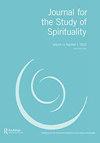作为精神的艺术:玛丽娜·阿布拉莫维奇的典型案例
IF 0.8
0 RELIGION
引用次数: 0
摘要
摘要本文的目的是通过一个实证案例来说明世俗时代的艺术如何成为艺术家和艺术追随者的精神非宗教环境。它将当代行为艺术家玛丽娜·阿布拉莫维奇视为植根于艺术世界的后现代精神人物的一个例子。她与世俗时代的相关性在于,作为一名当代艺术家,她发展了自己的艺术精神品牌,没有任何神学或宗教内容。尽管她不信教,但她并不符合物质主义的世界观。她持有许多所谓的“新时代”信仰,这使她成为SBNR人口中不断增长的一员。她开发了自己的“精神”方法来教授“精英”艺术世界之外的人,并创建了非物质的玛丽娜·阿布拉莫维奇研究所(MAI)来继承她的遗产。因此,可以说,她已经有效地将自己转变为一位“精神”老师。根据Denita Benyshek对艺术家萨满的建构、对缓解疼痛的科学解释以及Victor Turner对自发社区的概念,文章得出结论,Abramović是一个非宗教的精神魅力人物,她通过自己的表演、她的研究所和她的教育产生了反文化社区,提供了一个经验证明,艺术确实可以作为一种精神而非宗教背景发挥作用。本文章由计算机程序翻译,如有差异,请以英文原文为准。
Art as spirituality: The paradigmatic case of Marina Abramović
ABSTRACT The aim of this article is to illustrate through an empirical case how art in a secular age can function as a spiritual-but-non-religious (SBNR) environment for both artists and art followers. It examines contemporary performance artist Marina Abramović as an example of a post-modern spiritual figure, rooted in the artworld. Her relevance for a secular age is as a contemporary artist who has developed her own brand of art-based spirituality with no theological nor religious content whatsoever. Although nonreligious, she does not conform to a materialistic worldview. She holds many so-called ‘New Age’ beliefs which place her among the growing SBNR demographic. She has developed her own ‘spiritual’ method to teach people beyond the ‘elitist’ artworld, and has created the immaterial Marina Abramović Institute (MAI) to carry on her legacy. Arguably, therefore, she has effectively transformed herself into a ‘spiritual’ teacher. Drawing on Denita Benyshek’s construct of artist-shaman, scientific explanations about the relieving of pain, and Victor Turner’s concept of spontaneous communitas, the article concludes that Abramović is a nonreligious spiritual charismatic figure who is generating countercultural communitas through her performances, her institute and her teachings, providing an empirical demonstration that art can indeed function as a spiritual but not religious context.
求助全文
通过发布文献求助,成功后即可免费获取论文全文。
去求助
来源期刊

Journal for the Study of Spirituality
RELIGION-
CiteScore
2.50
自引率
7.10%
发文量
25
期刊介绍:
Journal for the Study of Spirituality is a peer-reviewed journal which creates a unique interdisciplinary, inter-professional and cross-cultural forum where researchers, scholars and others engaged in the study and practices of spirituality can share and debate the research, knowledge, wisdom and insight associated with spirituality and contemporary spirituality studies. The British Association for the Study of Spirituality (BASS) organises a biennial international conference and welcomes enquiries about membership from those interested in the study of spirituality in the UK and worldwide. The journal is concerned with what spirituality means, and how it is expressed, in individuals’ lives and communities and in professional practice settings; and with the impact and implications of spirituality in, and on, social policy, organizational practices and personal and professional development. The journal recognises that spirituality and spiritual values can be expressed and studied in secular contexts, including in scientific and professional practice settings, as well as within faith and wisdom traditions. Thus, Journal for the Study of Spirituality particularly welcomes contributions that: identify new agendas for research into spirituality within and across subject disciplines and professions; explore different epistemological and methodological approaches to the study of spirituality; introduce comparative perspectives and insights drawn from different cultures and/or professional practice settings; aim to apply and develop sustained reflection, investigation and critique in relation to spirituality and spiritual practices; critically examine the values and presuppositions underpinning different forms of spirituality and spiritual practices; incorporate different forms of writing and expressions of spirituality.
 求助内容:
求助内容: 应助结果提醒方式:
应助结果提醒方式:


